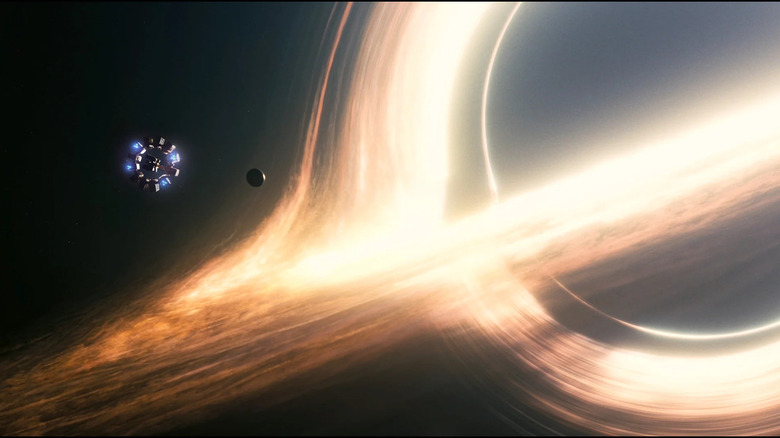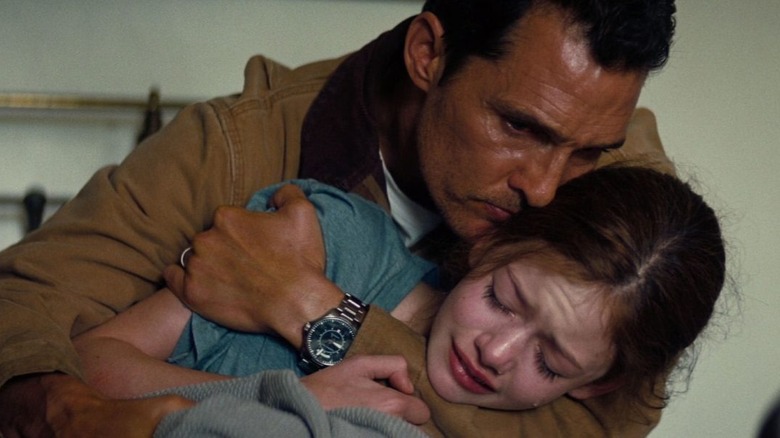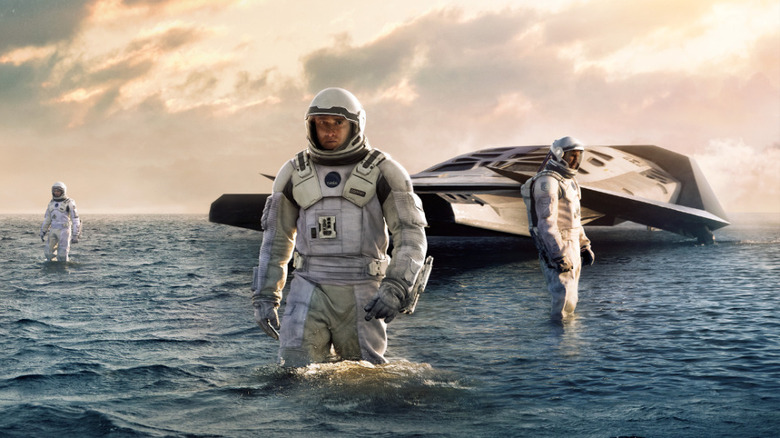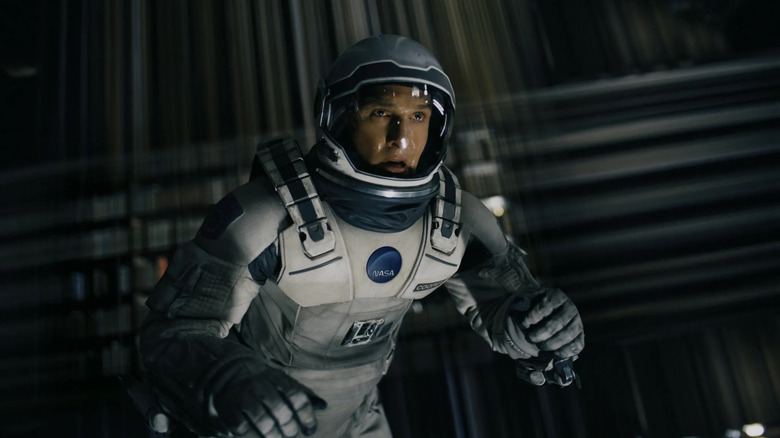10 Years Ago, Christopher Nolan's Interstellar Took A Giant Sci-Fi Swing
10 years ago on November 7, 2014, Christopher Nolan's "Interstellar" was released in theaters. The film was ambitious in technological scale and big in heart, but it had a somewhat divisive reception and currently holds a modest 74% score on Rotten Tomatoes, which is just 15% away from being classified as "Rotten." It has taken a decade for audiences to find a new appreciation for the film, with a 70mm re-release scheduled for December 6, 2024. Hollywood is now riding the wave of Nolan's Oscar win for "Oppenheimer," looking back on his previous work as a director and seeing his evolution in creating astonishing vistas, temporal labyrinths, and pulse-quickening spectacles.
Nolan's visionary and emotionally charged sci-fi film initially alienated many viewers and critics, but in hindsight, "Interstellar" stands as one of his best movies — dare I say, even better than "Oppenheimer," which often lingers on dry, bureaucratic drama. Furthermore, many of the more common critiques misunderstand how "Interstellar" creates a truly transfixing cinematic experience.
A galaxy of gargantuan proportions
Everything about "Interstellar is big," from the "2001: A Space Odyssey"-esque visuals of the vast galaxy to the walloping emotional punch the film's protagonist Cooper (Matthew McConaughey) endures as he watches decades pass in his family's lives before his very eyes. The consequences of Cooper's mission in the film — he must find a new home for humanity after Earth begins suffering from dwindling amounts of plant life in the year 2067 – are immense, with the entire fate of humanity resting on his shoulders. Yet, despite including an often-mocked scene that visually explains how wormholes work using a pencil and paper, there's a lot of other astrophysics jargon in the movie that many viewers found too confusing.
According to astrophysics lecturer Dr. Roberto Trotta, much of the film's science is hyperbolic or straight up wrong, despite Nolan having had physicist Kip Thorne serve as an advisor. For starters, Trotta has argued that the film's watery planet, where one hour on the surface equals seven years back on Earth because of gravitational forces, is unlikely. Trotta has also pointed out that Cooper's two-year journey to Saturn in the movie would actually take nearly five years, and that a scene where a robot is sent into a black hole to transmit data is nearly impossible, as the robot would be destroyed.
But with all due respect, who cares? All this cosmic complexity serves a story that has me on the edge of my seat. I don't need to fully understand the nitty-gritty of wormholes to be swept away by Cooper's travels to an unforgiving, unknown world that makes no promises — so far away from Earth, family, and the familiar. When I see Cooper desperately trying to make it back to his ship so that he doesn't miss any more time with his loved ones, and I hear Hans Zimmer's resounding score marking every minute of the clock that passes by, every drumbeat echoing my heart pounding in my throat, the last thing I care about is scientific accuracy.
Love transcends dimensions of time and space
At the same time "Interstellar" explores dense theoretical concepts, many critics and audience members felt the scene where Cooper's colleague, Dr. Brand (Anne Hathaway), declares love to be the "one thing we're capable of perceiving that transcends dimensions of time and space" was too simplistic and cheesy. But that's precisely the point. As I noted in my defense of the monologue for /Film's 50 Hottest Movie Takes, the use of such clear, uncomplicated, and yes, sentimental language stands out from the scientific vernacular to remind us that our relationship with one another is what matters most in this very high-stakes, intergalactic mission.
The crux of the film isn't just about traversing galaxies, exploring other planets, entering wormholes, or defying the laws of physics; this broad focus on love is what makes "Interstellar" so touching and powerful. It's what propels the movie forward. We would all try to save the ones we love, just as we would all be devastated about being ripped away from them for so long. It's a deep feeling that everyone can relate to.
While science explains so much about our lives, there is still lots about the universe that is shrouded in mystery. Who's to say there isn't some sort of celestial phenomenon at work when two individuals who are perfect for one another meet by happenstance? Or how about when someone develops a friendship that feels like family, thicker than blood? What about a family member who lives in your heart long after their death or no matter how far away you are from them? All types of love carry an invisible energy that pulls us toward the objects of our affection. Sure, we could cynically dismiss these connections as just chemicals reacting, but there must be something flowing between us that logic can't fully explain.
Radical sound mixing
The sound of "Interstellar" is as monumental as its epic story, from the ominous moans of spacecraft engines to the bellowing organs of Hans Zimmer's majestic orchestral score. Nolan once described the sound mix to IndieWire as "radical," while The Hollywood Reporter called it "adventurous and creative." However, many audience members and critics complained that the music and other sound effects drowned out the dialogue, making it difficult to fully understand every line. Nolan defended this stylistic choice to THR:
"Many of the filmmakers I've admired over the years have used sound in bold and adventurous ways. I don't agree with the idea that you can only achieve clarity through dialogue. Clarity of story, clarity of emotions — I try to achieve that in a very layered way using all the different things at my disposal — picture and sound."
The muddled sound mixing in "Interstellar" immerses viewers in the terror and uncertainty of what the characters are experiencing on their extraterrestrial journey. While it can certainly be frustrating to miss some dialogue (at least in the theatrical experience — captions are also an option when watching at home), the thunderous sounds evoke the disorientation of outer space. Nolan uses this sonic obfuscation to put you inside a spacesuit and alone on a distant planet, making you just as anxious and overwhelmed as Cooper and his team are on their harrowing mission.
Let the movie wash over you
"What I've found is that people who let my films wash over them — who don't treat them like a crossword puzzle or like there's a test afterwards — they get the most out of the film," Nolan told The Guardian in 2014. Likewise, you must let "Interstellar" wash over you and just experience it on a purely sensorial level, taking in all of its emotional grandeur and technical beauty. If you focus too much on whether the wormhole could really exist or matching up the timelines on Earth and in space exactly, you will miss the breathless tension of the docking sequence, trying to line the spacecraft up in record time; the surreal wonder of the Tesseract and its connection to the ghost of Cooper's daughter Murphy as a child (Mackenzie Foy); and Cooper's eventual heartrending reunion with his daughter, now an elderly woman (Ellen Burstyn). It's an uncanny moment that makes us reflect on the strong bond between parents and children, regardless of age, year, or circumstance.
The science fiction genre does not necessarily need foolproof science; fiction or fantasy is still just as much a part of it as science is. The best science fiction films use a combination of both for the audience to contemplate profound and extraordinary ideas about human existence and the future. "Interstellar" makes a bold declaration that love is a powerful and even tangible force in the universe; this may not be anchored in any observable truth, but isn't it a beautiful idea?




